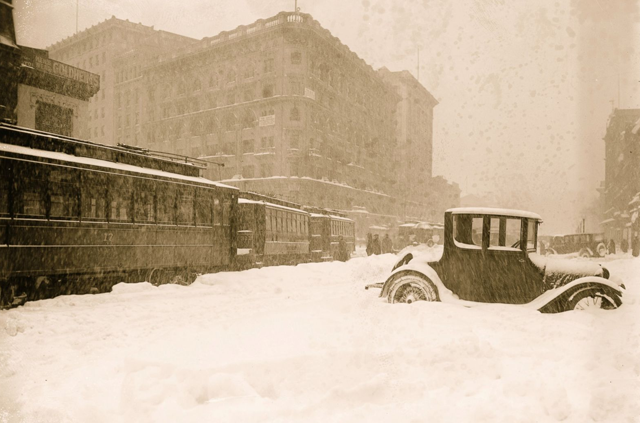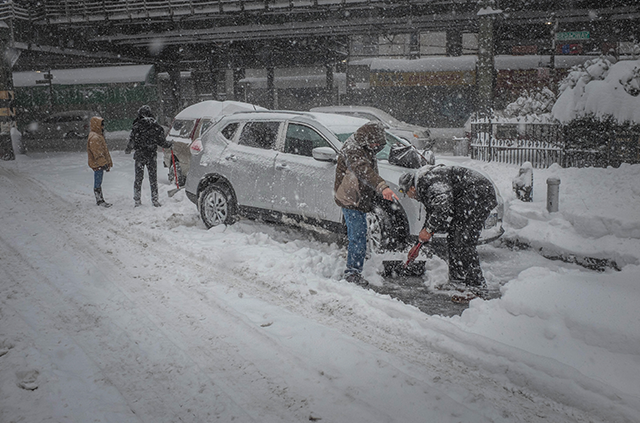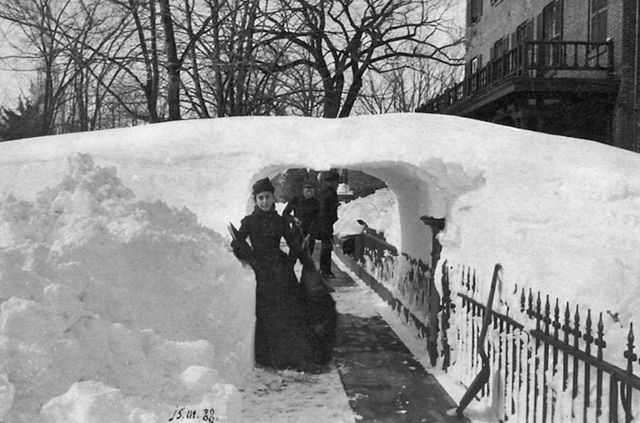If you live in the Northeast, you’ve been through your fair share of snowstorms. You probably even have a memory of your own worst snowstorm – when the snow piled up high against your door, or the power went out, or school was closed for a week. In honor of Mother Nature’s icy and relentless wrath, we present the biggest blizzards and worst snowstorms in United States history.
The Great Blizzard of ’88
In March of 1888, the Northeast was faced with one of the worst blizzards in American history. Also known as the Great White Hurricane, the Great Blizzard of ’88 left as much as 55 inches of snowfall in some areas, and caused disaster wherever it went. The entire area from Washington, D.C., to Maine suffered from brutal winds, massive snowdrifts and catastrophic damage. Over the course of the three-day blizzard, over 400 people were killed. Major cities like New York City and Boston ground to a halt as their railway and telegraph lines were buried or destroyed. The disastrous effects of the Great Blizzard of ’88 actually inspired Boston to create the first underground subway system in the country.

The Knickerbocker Storm – 1922
On Jan. 28, 1922, more than 2 feet of snow fell on Washington, D.C. The weight of the snow collapsed the roof of the Knickerbocker Theatre, killing 98 people. This led to stricter building codes to prevent such a tragedy from ever happening again. To this day, the Knickerbocker Storm holds the record for the most snowfall in D.C., and the Knickerbocker Theater’s collapse remains its deadliest disaster.
The Great Appalachian Storm – 1950
On Thanksgiving weekend of 1950, as much as 62 inches of snow blasted the central Appalachians. As if that wasn’t enough, the area was also beset by frigid cold and intense wind storms. Right after the storm passed, temperatures became unseasonably warm, which led to extensive flooding from the snowmelt. Overall, the Great Appalachian Storm of 1950 caused at least 160 deaths.
The Blizzard of ’78
The Blizzard of 1978 struck on Feb. 5, and didn’t dissipate until two days later. The nor’easter broke snowfall records in Boston (27.1 inches), Providence (27.6 inches) and Atlantic City (20.1 inches). The huge amounts of snow dumped by the storm were matched with hurricane-force winds and coastal flooding. The severity of the blizzard hadn’t been anticipated, and many people were forced to shelter in place for days at a time. Motorists found themselves stranded in their cars in the middle of snowy highways. An estimated 100 people lost their lives.
The Storm of the Century – 1993
In March of 1993, a great cyclonic storm formed in the Gulf of Mexico. As the storm progressed up the East Coast, it began to snow in regions as far south as Alabama and Georgia. The snowstorm stretched from those Southern regions into Maine and even Canada. The affected areas were battered with unseasonably frigid temperatures, powerful wind gusts and up to 60 inches of snow. At one point, every major airport on the East Coast was closed. It was one of the first major storms predicted several days in advance thanks to computer forecast models. While the advanced warnings no doubt saved lives, 318 people still lost their lives. The Storm of the Century is known as one of the deadliest American storms of the 20th century.
The Great Blizzard of 2003
From Valentine’s Day to Feb. 19, the Great Blizzard of 2003 swept across the Mid-Atlantic and the Northeast. Every major city from Washington, D.C., to Boston was covered in an enormous blanket of snow, with many areas getting up to 2 feet. Airports across the Northeast suspended flights and shut down operations completely, while New York City, Boston and Philadelphia transformed into icy ghost towns as residents hunkered down against the bitter cold. The Great Blizzard of 2003 caused 27 deaths and put an entire region of the country on hold.
Snowmageddon – 2010
In February of 2010, two blizzards – one on Feb. 4-7 and one on Feb. 9-11 – hit within just days of each other. Most people agree that “Snowmageddon” refers to the first blizzard, but the second storm is sometimes included in the term. However you define it, it was called “Snowmageddon” for a reason: The storm wreaked havoc across the country, icing over roads in New Mexico and shutting down the federal government in the nation’s capital. The massive storm also led to transportation shutdowns and power outages, and killed 41 people in the U.S. and Mexico.

Snowzilla – 2016
A January 2016 blizzard, hailed as Snowzilla, paralyzed the entire East Coast, leaving hundreds of thousands without power. Snow fell in areas as far south as Georgia, Alabama and even the Florida Panhandle. With intense snowfall, hail, wind gusts and whiteout conditions, it was unsafe to travel even short distances. In all, 55 people lost their lives. The snow reached a maximum height of 42 inches in Glengary, W.V.
December 2022 North American Winter Storm
The most recent storm on the list hit the United States and raged on from Dec. 21 to Dec. 26. The December 2022 North American Winter Storm was a bomb cyclone that buffeted the Midwest and the Great Lakes region with blizzard conditions, even dumping as much as 55 inches of snow in Buffalo, N.Y. A wide swath of the country also experienced extremely cold temperatures, even if they didn’t get hit with any snow. The unprecedented scope of this storm is estimated to have affected 60% of Americans, who received winter weather advisories or warnings, and caused massive disruptions for travelers during the busy Christmas season. As a result of the storm, 106 people across the United States and Canada lost their lives.
What’s the worst snowstorm in United States history that you remember? How did you stay warm? Tell us your story in the comments below.
49 Thoughts on “The Worst Snowstorms in United States History”
Leave A Comment
Comments are subject to moderation and may or may not be published at the editor’s discretion. Only comments that are relevant to the article and add value to the Your AAA community will be considered. Comments may be edited for clarity and length.













So much for the fearmongering of “climate change”. Since time immemorial, climate is ALWAYS in flux. Explain the effects of “climate change” and the Great Blizzard of 1888? I’m sure there were many other blizzards and snowstorms prior to 1888.
You missed a couple! The winter of ’57-’58 brought a 27-foot snowdrift across State Route 10 into our town in Schoharie County, NY. All roads in & out of town were closed for three days. Farmers had to dump their milk because it couldn’t be delivered. I remember it vividly, and I have photos! Old timers tell us that another similar storm hit the town in the winter of ’38.
There needs to be a correction. What about the winter blizzard of 1996. It started Sunday, Jan. 6th and didn’t stopped until Jan. 8th. Some parts of New Jersey got over 31 inches.
Jan 1985 in San Antonio, Texas saw 13 plus inches of snow in 2 days. The city was paralyzed. We don’t have the snow plows to clear the streets.
No mention of the Blizzard of 1996? I remember coming home not seeing the front of my ranch house because the drifts covered the entire front right up to the top of roof. We got 28″ that storm.
tHE ONLY WEATHERMAN TO ACCURURELY
PREDICTLY THE BLIZZARD OF 1978 WAS
STEWART SUROCCA OF WBZ BOSTON
Harvey Leonard also predicted the Blizzard of ’78.
I had to shelter in place at my friend’s house in Wareham MA during the “100 Hour Storm in 1969.
DISCUSSION: As we step back to February 22-28th, 1969, weather history was most certainly changed forever in a very profound way. This one-week period marked the occurrence of one of the longer snowstorms in recorded history across the New England section of the northeastern United States. The famous “100-Hour Storm” began across the greater Boston, Massachusetts metropolitan area during the earlier parts of this 7-day period. Snow fell much of the time between early on the 25th of February and right through noon on the 28th of February. The 26.3 inches of new snowfall reported at Boston Logan International Airport still remains to be the 2nd largest single snowstorm snowfall total in Boston’s history.
I WAS A TELEPHONE MAN WORKING IN NORTH OF AKRON AT THE UNIVERSITY, I WALK UP DRIFTS TO THE BLACK BAGS ON THE TELEPHONE POLES . IT WAS GREAT AT THAT TIME.
February 1987. not one storm exactly. no school for entire month on cape cod
The blizzard of 1977 was devastating in Buffalo, NY. Several people died in the snow storm. I see the list of blizzards is growing on this site. They are all dangerous, however, the kids love them because the schools are all closed for 3-4 days! Stan K.
The worst snowstorm I remember was in the winter of ’57-’58. Our small town in the western Catskills was closed off from the rest of the world for three days – until larger, stronger snowplows could be brought in from a larger town nearby. Our barn collapsed under the weight of the snow, and farmers had to dump their milk since they couldn’t take it to the creameries. The largest drift (across State Route #10) was measured at 27 feet. My dad took a photo of me standing next to that drift after the snowplows were finally able to get through, and a friend of mine’s father took a photo of him sitting on top of the drift, looking down at the electric power lines.
April 1982, with over a foot of snow.
While maybe not the most snow but it was April. School was shut down for days which as a kid was so fantastic!
April (Fool’s Day) 1997 – Massachusetts got 10-30 inches depending on where you were in the state.
October 2011 – definitely not the snowiest but very destructive. It shut down so many in northeast for 1-2 weeks with loss of power/heat/mobility.
Addie, Yes, the Friday, October 28, 2011 storm was a beaut. I barely made it home from work five miles away, having to change my route multiple times due to impassable roads. The trees snapping all night and through the next morning certainly was one of the craziest situations in which I’ve been.
We finally got the power back on the next Saturday.The Generac sure got a workout during those eight days.
You have left out many snowstorms that happened. !962-63 Northeast had very heavy snow. Interstates closed.
1948-49 northern NJ very heavy snow. I remember bulldozers plowing the roads. 1970’s N.J. had 21 snowstorms.
I remember all of the the blizzards from 1950 to the present.
The Blizzard of ’78 came after several earlier snow storms had dumped many inches of snow in the region. The prior storms had caused school closings and left huge piles of snow. Add in that the storm was only correctly predicted by one weatherman with everyone else dismissing it. Those of us who went to the Beanpot Tournament at the Boston Garden either ended up staying in The Garden or stranded somewhere on our way home. One thing that was great was how everyone helped each other.
Harvey Leonard predicted it.
The only one to nail that forecast was Bruce Schwoegler on WBZ.
The Blizzard of ’66 in upstate NY. The snow was up to our roofline and we were socked in for at least 4 days.
I can’t believe you didn’t include the blizzard of Feb 1966. Roads closed for 3 days in upstate NY.
Back in the 1950’s we had a winter storm that knocked out the electric for days. However, we had a coal hot air furnace and a bottle gas stove. All we needed was candles for light. Back in the good old days in the Berkshires!
I have lived in some very snowy places, but the one blizzard that stands out in my memory was the Blizzard of ’78. My husband barely got into our street on his way home from work in Boston, and the snow just kept coming. When it stopped we couldn’t see out the front door because the snow was up to about 8 inches from the top. My husband opened the door and found a perfect impression of the door in the snow. We lived in Andover and the streets got plowed pretty well, but the snow banks were so high that no one on our cul-de-sac could find their mailboxes until spring. Our daughter was ill and had been exposed to strep, so the doctor told us to take her to his office. We were under Marshall Law for days, but no one stopped my husband from driving to see the doctor. The plow drifts were so high that cars couldn’t see around them at intersections and needed a second person to get out to guide them through the intersection. We have photos of our kids sitting on top of the snow plow drift where our mailbox should have been, and the pile is over 5 feet high. The snow was so deep we had to let our dog outside on a sheltered porch or she would have been buried (she was a large dog). After that storm the weather men described it as a ‘white hurricane’.
You were so lucky that you managed to get your daughter to the doctor just in time to get treated for Strep. Strep, as we all know, is extremely dangerous if it goes untreated or is undertreated. Glad your daughter was able to get treated by the doctor and she got well, and is okay.
The earliest storm I remember vividly is the Blizzard of ‘78. I was 7 years old and all that mattered at that age was no school for a week! My brother and I would sled down the snow banks in front of our house, once we were able to get outside. There was a convenient store about a mile away from our neighborhood that stayed open. My Dad pulled me on a sled to get there to get some necessities. We lived off of a normally very busy street but since roads were closed there were just loads of people walking right up the middle of the street. Us kids loved it…the adults, not so much. 😄
I, too, remember the blizzard of ’78. I was going to Boston University’s long since defunct Program in Artisanry. Because I was living downtown, in a dorm, I was able to get work done in the studio. It seems that, especially out on weekends, that everybody was out walking around afterwards. I met several people that I knew, as well.
The early 2015 storms in Boston area was crazy .
As a snow operation co here I can attest to a lot of snow.
It’s very similar season as 2023 no snow warm days lots of rain
When 2015 started the first storm (blizzard) luckily was on the weekend. The first was around early Feb as I recall about 26 inches. 1 week later starting Friday nite going into Saturday another 28 inches. The following week almost 7 days another 28 to 30 inches.
We would get everything cleaned up pushed back by late Tuesday , Wednesday go get sleep and I could not believe when the weather man said another blizzard on the way. In Boston there was no place to put the snow so after the second blizzard they removed and stock piled snow. The pile was so high they were pushing it with a d 9. Dozer. Finally early March we caught a break snow subsided and warmer temps came to melt snow
Luckily it was a slow melt down.
The pile of snow in Boston was so large that it finally melted completely by September crazy
Blizzard of April 1973 in the Midwest.
How could you leave out the Blizzard of 1966? I lived in Fulton, New York (north of Syracuse) and we were snowed in for a week. 7 feet of snow as I recall. I remember skiing several miles with my father to the nearest grocery store to get food. No storm since has ever compared to it.
Hi Tom,
I grew up in Fulton as well and I recall your name although I think you might be a few years younger than me. My dad was a Fulton cop and he couldn’t get home for days after that storm! All other storms have paled in comparison to 1966! Live in CT now and they have no idea what snow is -LOL! Hope you are well!
Patricia
We should at least get an honorable mention for central CT for the storm that hit on February 9, 2013. Meriden, where I live got 30″, while Hamden reported 40″. It was two or three days until the main roads reopened, as the normal plows could not handle it. They needed payloaders and a truck mounted industrial snow blower to clear many of the streets.
I was living in Hamden during that storm and we definitely got 40 inches; however, I was vacationing in Florida at the time and saw our town on the news down there!
February 2015 in Boston–sometimes referred to as “Snowpocalypse” and “Snowmaggedon” (Noted above in a comment). It actually began on January 26 and ended on March 3. Snowpocalypse was a series of storms–about two a week–that dumped approximately 9 feet of snow on the Boston area over 6 weeks and paralyzed the region. It was so cold (around 18 degrees F on many days) that the accumulated snow did not begin melting until March, and the entire public transportation system–subways, buses, commuter rail–ground to a halt for days. It revealed so many problems with Boston’s infrastructure that it helped undermine the city’s subsequent bid to host an upcoming Olympics. I recall walking down the middle of Beacon Street in Somerville during morning rush hour. There was no traffic and it was the only plowed path where you could walk without snowshoes.
I lived in Somerville during the Blizzard of ’78, an unforgettable experience. In 2015 I was living in my hometown of Wareham, MA. It seemed it would be a mild winter, until the third week in January. Then it started snowing really hard and essentially continued for six weeks, one blizzard after another. I ended up moving because of that winter. My neighborhood was never plowed sufficiently. An enormous tree fell across the main road and made it impassable for days. Thank God there was one alternate way out. We lost power for five days (some neighborhoods even longer). My home had electric heat, hot water, electric stove, everything. I had a lot of candle light, and was only warm when I was huddled in bed under down comforters with my little dogs. the money I spent that winter on snow removal was horrifying. I moved that year to a more centrally located area, with a gas stove, good plowing by the neighborhood association, and no hills. It’s really something how in this day and age the weather can still control our lives.
The Blizzard of 1947 NYC area. It was referred to as the Christmas Storm over 2 days (December 26-27) almost 27” of snow fell with high winds.. I vaguely remember being pulled on a sled by my mother while being held by my sister. We were trying to get to a food store a few days right after the storm… Obviously a great time being a child!
1978! The year I graduated high school. In a small town just north of Providence we were hit bad. My father was stranded in his car trying to get home from work in Providence and then brought to a shelter that was set up by the National Guard where he stayed for 4 days. We didn’t know where he was for the first two days. I remember my mother perking coffee and heating up canned soup on a charcoal grill that we dug out of the garage. My siblings and I set out on foot to the main road once the snow let up to see if anyone needed help or shelter. School was closed for 8 days. The baker in our corner Italian bakery was stranded in the bakery, so he baked bread and walked through the streets pulling a wagon full of bread passing it out to the neighbors until he ran out of supplies. My High School year book dedicated a section to the storm with pictures and stories.
In March 1993 I was living in a large apartment complex in Newark, Delaware. The snow started in the wee hours of Saturday the 14th(?) and lasted until it laid down 10 to 11 inches of snow. Then, after a brief lull, the precipitation turned to rain on Saturday night, which then froze overnight. On Sunday morning we all awoke to a 3/4″ layer of ice on top of the snow. Snow shovels were useless. I didn’t own one (a few of my neighbors did), but what I did own was an aluminum softball bat. So we teamed up — I would break up the ice with my bat and they would then shovel the pieces away. I ended up helping push eleven cars out of their parking lot tombs that day!
The December 2022 storm needs a better name. I vote for “The Nightmare Before Christmas – of 2022”. Which is quite fitting not only for the meteorological mess but the travel chaos it caused as well!
I can’t believe you omitted the huge snowstorm of 1947. It started snowing on December 26th and only stopped after dumping 26.4 inches on N.Y.C. I lived in Queens at the time and we dug out a tunnel from one side of the street to the other of our dead end street. What a great time we had .
It’s really great 👍
In 1973 when I was about 8 years old, I lived in central South Carolina. We actually had a blizzard with snow fall totals in some places getting over 2 feet between Columbia and Myrtle Beach! Of course in SC there was no snow removal equipment or salt for the roads. South Carolina had to barrow snow removal equipment from North Carolina.
I was 11 years old when the northeast blizzard of 1978 hit. The winds in the center of the storm were 112 mph. We got lucky, we were in central New Jersey when it hit. We were in the house and we stayed in the basement thinking that the roof was going to collapse. We got the 85 mph winds and got lucky. In two days the snowfall rate was 3 1/2-4 inches per hour. The coastal shoreline of New Jersey and Rhode Island was destroyed. We were out of school for two weeks. It was waist deep with snowdrifts up above the 2nd story of many houses. More than 100 people died. Temperature during the storm reached around-55-60 below zero wind chill. Lots of people froze to death. They had bulldozers dig out freeways and roadways and businesses. That was Feb 5th and 6th , 1978. It was a cat 2 hurricane in the middle of winter.
Two storms come to mind: Storm of the Century (1993) and The Big Freeze of Texas (2021). In 1993 I was in GA, at the time the state and cities were COMPLETELY UNPREPARED in dealing with snow. I was stuck for 3 days in my girlfriends condo, like a forced stay-cation. We made the best of it to keep warm. 🙂
The Big Freeze of Texas was another story. My family and I were fortunate, because we would only lose power for hours at a time, not days. We never lost water pressure. We had enough firewood to get through the winter, or so I thought. The six of us (me, wife and kids) huddled around the fireplace and played board games by candlelight, for most of five days. When the power came back on we knew we only had a couple of hours to cook, shower, and prepare for the next outage. Other parts of Texas lost power and water for a full week. Temps were approaching ZERO degrees, something Texas never had to deal with before.
I was 6 years old during the Blizzard of 78’ in Northwest Ohio. I remember the snow covering our glass door with only inches of light at the top. It was weird seeing snow packed together through that glass. Once my step-dad dug us out to get out the door, the snow was as high as our neighbor’s shed. My older sister and I were sledding off from the top of that shed which was at least 1 story high. The snow had drifted in many places really high because, well, it was a blizzard. Our cars were completely buried. There was no help for days and the power went out. Then my parents had to cut up furniture to burn in our fireplace that had a wood burner inserted in it to keep us alive. We all had to sleep near the fire because the back bedrooms were too cold to sleep in. We had to cook our food on pans on top of that wood burner. I will never forget and have always had a sense to be prepared for storms after that.
Snowpocalypse – spring 2015. It probably didn’t make the list because it wasn’t a single storm or two major storms but the snow piled up and up vs other years when snow melted away between storms.
When I was six years old I remember going up to our cabin and it’s not so much the night before that we had to dig out the driveway to get up to the cabin and I remembered following my dad‘s footsteps, and the snow went up to my chest a good 4 feet of snow fell that night. It is really heavy wet snow so it’s extremely hard to walk. I will never forget that slow walk up to the cabin porch. My dad also feared that the cabin roof would collapse. So with the older children my mom and my dad went up to the roof and shoveled snow off for hours to make sure that the roof didn’t have more snow on it. That was a crazy winter!
January 1996. Northern New Jersey. My husband fell in the house and broke his ankle during the blizzard. The ambulance crew had to shovel to get to the house. It was snowing so hard that they had to shovel again to get him out to the ambulance. They got stuck 2 times on their way to the ER. The surgeon on call couldn’t get in until the next day. When it stopped snowing, it was so deep that my car was up to the bottom of the windows in snow. Family dug me out 2 days later.
In the winter of 1947-1948, the snow storm that occurred in N.Y.C. totally paralyzed the city. Public transportation and automobiles came to a halt and food stores were closed for days. I lived in Sunset Park, Brooklyn at the time; I was 11 years old and had recently arrived to New York! There must have been at least 5 feet of snow! I’ve never forgotten it.
In the early 1940’s a huge snowstorm blasted New York City. So much covered the ground that I remember seeingkids on my block, East 52nd Street, building an igloo. The steam radiators in our apartment were really banging away.